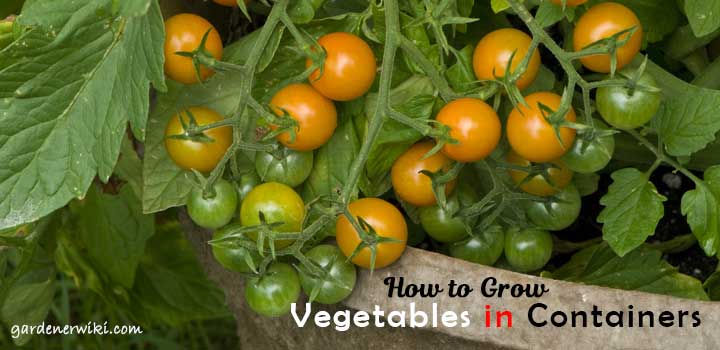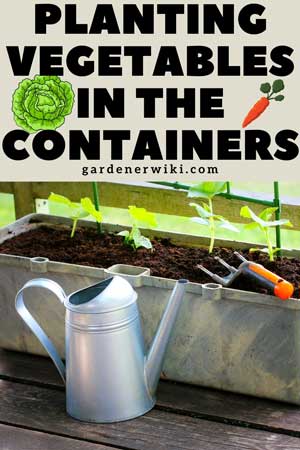Not every vegetable can be grown in containers, leading people to think that they can’t make their own garden unless there’s a soil bed.
Most of us don’t know that some vegetables do great in containers, and this is why container gardening is a viable option for those with no access to soil beds. Container gardening can be a bit challenging to get started with. Hence, I’ll discuss how to grow vegetables in containers step-by-step so it’s easy for you to get started!

How to Grow Vegetables in Containers
Let’s dive directly into the process of growing vegetables in containers.
Step 1: Picking the Right Container
When gardening in containers, it’s crucial to pick a suitable container for yourself, or you’ll face tons of challenges in your journey. In this section, we’ll discuss how to choose the type and size of the container.
- Which Size Should You Pick?
It’s often said that the bigger the container is, the better. A bigger container will provide space for planting many vegetables, and maintaining one is much simpler and easier than the smaller ones.
The main advantage of these pots is that they can absorb more water, and thus they can retain the moisture longer. So, you won’t have to water these as much.
It’s tough to think of any other shape than the regular round when it comes to pots. However, I recommend going for the barreled ones, window baskets, and even the bushel baskets. These look unique. While choosing, make sure that the container is at least 12 inches deep and 10 inches wide.
- Which Type of Container Should You Go for?
The type of container that you’re picking matters for the plants; plants don’t care about what the container is made of. All they require is a container large enough for spreading their roots. It must come with drainage holes too.
Try not to pick a container with dark color, as these can absorb the heat and light. The warmer condition can be detrimental for certain vegetables in summer. Terra cotta containers look great, but they need to be watered more often because of their porous nature.
I highly recommend you look for light containers. After you water the plant, the container gets pretty heavy and can be very hard to move. One material I suggest avoiding is treated wood. Treated wood can supply chemical compounds that can harm vegetables and plants.
Step 2: Picking the Right Type of Potting Soil
Potting soil is the type of soil that’s used in containers for gardening. It isn’t like regular garden soil but is much fluffier and lighter than regular garden soil. Potting soil often comes with plant food.
Although the plants don’t care much about the container they are kept in, they do care about the soil. You can purchase or produce different types of potting soils. You can categorize them into three main types. These are:
- Cutting Mix
When you start a new seedbed, these starter mixes can help you prepare the right soil bed for the vegetables. These are incredibly light, so they are considered the perfect type for growing the baby roots.
- Succulent Vegetable Mix
If you’re planting succulent plants, then you’ll need a lot of aeration in the soil. These mixes are prepared with a high amount of wood barks and perlite
- All-Purpose Mix
These are all-rounder soils that offer a great balance between water retention and drainage. You can plant almost any type of vegetables on this soil because of their traits. However, these don’t come with any plant food.
When putting potting soil for vegetables in containers, you shouldn’t fill the container to the brim. It’s recommended that you keep the soil level at least 2 to 3 inches lower than the pot. That will keep the container from overflowing when you water it.
Step 3: Planting Vegetables in the Containers
It’s tough for beginners to pick a specific plant for container gardening. If you’re just starting, select a vegetable you like.
It’s also important to pick a vegetable that’s easy to maintain and one that you can plant in a container.
While you can plant most vegetables in containers, not all of them will provide the best result when you do so. That’s why you must research before settling for a plant.

During the plantation, make sure there are at least three inches of gap between each plant. This will allow the roots to grow freely and without getting tangled with one another. Plus, it’ll also let them gather nutrition from the soil easily.
It’s important to remember that not all of the planted seeds will germinate. That’s why I’d say – the more plants, the better. After you’re done planting, stick some plastic tags to help you determine the plant later on.
You can fertilize either before or after the plantation. However, I advise fertilizing the soil beforehand. This will help the plants receive nutrition from the beginning. Over-fertilizing can help the plants grow faster than they are supposed to. However, the vegetables will lose their taste if over-fertilized, so I recommend avoiding this. To determine the amount of fertilizer you should apply, check the fertilizer you’re using.
Step 4: Taking Care of the Vegetables
It’s important to care for vegetable garden to ensure the plants grow without any hindrance. The most important way of taking care of your plants is by watering them.
You should check the pots at least twice a day to check whether it’s dry or not. Dry soil is one of the major causes of wilting.
Plus, it’s also important to keep an eye out for pests and diseases. Container plants are much less susceptible to infections than garden plants. If you remain cautious about them, the plants will grow without any disease.
Tips to Follow for Growing Vegetables in Containers?
Some important tips you should follow while growing vegetables in containers. It makes your vegetable cultivation easier and faster when it comes to growing in containers.
- Prepare a well-drained container and use good-quality soil.
- Water your vegetable container regularly and track the daily growth.
- Avoid over watering the seedlings; otherwise, they can catch diseases.
- Use fertilizer to ensure better and quick growth.
- Maintain a good drainage system on the container to grow vegetables.
- Keep the containers in the direct sun for 3 to 8 hours, depending on different seasons.
FAQs
What compost to use for growing vegetables in containers?
Peat-free moss and fresh organic compost are the best for growing vegetables in containers. You can collect organic compost from your kitchen. And don’t use meat, oil, and other wet debris.
Is it OK to water vegetables every day?
It’s necessary to water the seedlings daily for better germination. But when it grows, you have to water it three times a week.
Conclusion
These are the steps that you can take for growing container vegetables. If done correctly, you’ll be able to enjoy tasty vegetables that you grew all by yourself! So, I highly recommend going through this guide on how to grow vegetables in containers once again, just to ensure you make no mistakes in the process.